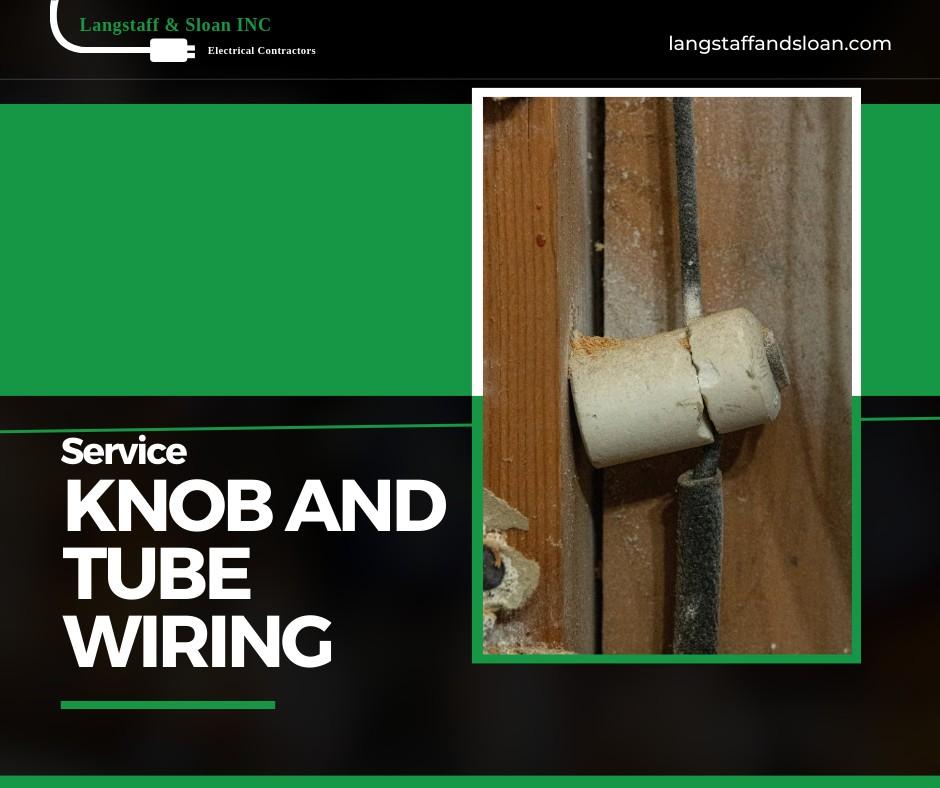The History and Challenges of Knob and Tube Wiring in Canada: What Homeowners Need to Know

Knob and tube wiring, often referred to as knob-and-tube or simply K&T, is a relic of early electrical systems that powered homes across Canada in the late 19th and early 20th centuries. As one of the first standardized methods for electrical wiring in residential buildings, knob and tube electrical systems were revolutionary for their time. However, as technology has advanced and modern electrical demands have grown, knob and tube wiring in Canada has become a topic of concern for homeowners, electricians, and insurers alike. This guest post dives into the history, characteristics, challenges, and considerations of knob and tube wiring, offering insights for Canadian homeowners navigating this outdated system.
What is Knob and Tube Wiring?
Knob and tube wiring is an early form of electrical wiring used predominantly from the 1880s to the 1940s in North America, including Canada. The system gets its name from the ceramic knobs and tubes used to secure and insulate the wiring. Here’s a breakdown of its components:
-
Ceramic Knobs: These were nailed to wooden joists or beams to hold the wires in place, keeping them separated from the wood to prevent fires.
-
Ceramic Tubes: These were used to protect wires as they passed through wooden framing, such as studs or joists, ensuring insulation from the surrounding structure.
-
Single-Insulated Wires: Unlike modern wiring, which uses bundled cables with multiple conductors, knob and tube systems used single copper wires with cloth or rubber insulation to carry the hot and neutral currents separately.
Knob and tube wiring was designed for low-power electrical loads, such as lighting and basic appliances. It was not built to handle the heavy electrical demands of modern households, which rely on numerous devices, including computers, air conditioners, and home entertainment systems.
The History of Knob and Tube Wiring in Canada
Knob and tube wiring emerged during a transformative period in Canada’s history when electricity was becoming widely available in urban and rural areas. By the early 20th century, cities like Toronto, Montreal, and Vancouver were rapidly electrifying, and knob and tube electrical systems became the standard for residential wiring due to their simplicity and affordability.
In Canada, knob and tube wiring was particularly common in homes built before World War II. Many heritage homes in neighborhoods like Toronto’s Annex, Vancouver’s Strathcona, or Montreal’s Plateau still contain remnants of this system. At the time, it was considered a safe and reliable way to deliver electricity, adhering to the electrical codes of the era. However, as electrical standards evolved and the Canadian Electrical Code (CEC) was updated, knob and tube wiring fell out of favor due to its limitations and safety concerns.
Why Knob and Tube Wiring is Still Found in Canadian Homes
Despite its obsolescence, knob and tube wiring persists in many older Canadian homes for several reasons:
-
Durability: When properly installed and maintained, knob and tube systems can last for decades. The copper wiring and ceramic components are highly durable, and many systems still function in homes over a century old.
-
Cost of Replacement: Replacing knob and tube wiring is a significant investment. Rewiring an entire home can cost thousands of dollars, prompting some homeowners to delay upgrades.
-
Historical Preservation: In heritage homes, owners may resist replacing knob and tube wiring to preserve the historical integrity of the property, especially if the system is still functional.
-
Lack of Awareness: Some homeowners are unaware that their homes contain knob and tube wiring or are unsure of the risks associated with it.
Challenges and Risks of Knob and Tube Wiring
While knob and tube wiring was innovative in its time, it poses several challenges and risks in modern Canadian homes. Here are the key concerns:
1. Lack of Grounding
Knob and tube electrical systems do not include a grounding wire, which is a critical safety feature in modern wiring. Grounding protects against electrical shocks and reduces the risk of fire by providing a path for stray electrical currents. Without grounding, knob and tube systems are less safe, particularly for sensitive electronics.
2. Insufficient Capacity
Knob and tube wiring was designed for minimal electrical loads, typically supporting lighting and small appliances. Modern households, with their reliance on high-power devices like microwaves, HVAC systems, and electric vehicle chargers, can overload these systems, leading to overheating and potential fire hazards.
3. Aging Insulation
The cloth or rubber insulation used in knob and tube wiring degrades over time, becoming brittle and prone to cracking. This exposes the copper wires, increasing the risk of short circuits, electrical shocks, and fires. In Canada’s harsh climate, where temperature fluctuations can accelerate insulation deterioration, this is a significant concern.
4. Insurance Issues
Many Canadian insurance companies are reluctant to insure homes with knob and tube wiring due to the fire risks associated with outdated systems. Some insurers may require homeowners to replace the wiring entirely or charge higher premiums to offset the risk. This can be a major issue for homeowners looking to sell or refinance their properties.
5. Code Compliance
The Canadian Electrical Code no longer permits the installation of knob and tube wiring in new construction or major renovations. While existing systems are grandfathered in, any modifications or extensions to knob and tube wiring must comply with modern standards, often necessitating a full replacement.
6. Incompatibility with Modern Fixtures
Knob and tube wiring is not compatible with modern three-prong outlets, ground-fault circuit interrupter (GFCI) outlets, or arc-fault circuit interrupter (AFCI) breakers, which are now required in many parts of a home under the CEC. This limits the ability to upgrade electrical systems without replacing the wiring.
Identifying Knob and Tube Wiring in Your Home
For Canadian homeowners, particularly those in older homes, identifying knob and tube wiring is an important step. Here are some signs that your home may have this system:
-
Age of the Home: If your home was built before 1950, there’s a good chance it contains knob and tube wiring, especially if it hasn’t been renovated.
-
Ceramic Components: Check your basement, attic, or crawl spaces for ceramic knobs or tubes holding wires in place.
-
Cloth-Covered Wires: Knob and tube wiring often uses cloth-covered wires rather than the plastic insulation found in modern systems.
-
Two-Prong Outlets: Homes with knob and tube wiring typically have two-prong outlets instead of the grounded three-prong outlets used today.
-
Frequent Electrical Issues: If your home experiences flickering lights, blown fuses, or tripped breakers, it could indicate an overloaded knob and tube system.
If you suspect your home has knob and tube wiring, hire a licensed electrician to conduct a thorough inspection. They can confirm the presence of the system and assess its condition.
Options for Homeowners with Knob and Tube Wiring
For Canadian homeowners with knob and tube wiring, there are several options to consider:
1. Full Replacement
The most recommended solution is to replace knob and tube wiring with modern wiring that meets current CEC standards. This typically involves installing copper wiring with PVC insulation, grounded outlets, and modern circuit breakers. While costly, replacement ensures safety, increases electrical capacity, and improves insurability.
2. Partial Replacement
In some cases, homeowners may opt for a partial replacement, focusing on high-traffic areas like kitchens and bathrooms. This can be a cost-effective compromise, but it may not fully resolve insurance concerns or eliminate all risks.
3. Retrofitting with Grounding
In rare cases, electricians may be able to retrofit grounding to certain parts of a knob and tube system. However, this is complex and may not be feasible for all homes, and it still doesn’t address capacity or insulation issues.
4. Regular Maintenance and Inspection
If replacement isn’t immediately feasible, regular inspections by a licensed electrician can help monitor the condition of the wiring. Avoid overloading circuits, and refrain from making unauthorized modifications to the system.
The Cost of Replacing Knob and Tube Wiring in Canada
The cost of replacing knob and tube wiring in Canada varies depending on the size of the home, its location, and the complexity of the project. On average, homeowners can expect to pay between $8,000 and $15,000 for a full rewiring of a medium-sized home. Factors that influence the cost include:
-
Home Size: Larger homes require more materials and labor.
-
Accessibility: Homes with difficult-to-access areas, such as tight crawl spaces or finished walls, may incur higher costs.
-
Location: Labor rates vary across Canada, with urban areas like Toronto and Vancouver typically being more expensive.
-
Additional Upgrades: Installing new outlets, circuit breakers, or a modern electrical panel can add to the cost.
Homeowners should obtain multiple quotes from licensed electricians and ensure that the work complies with the Canadian Electrical Code.
Knob and Tube Wiring and Home Sales in Canada
For homeowners looking to sell a property with knob and tube wiring, the system can complicate the process. Potential buyers may be wary of the safety risks and insurance challenges, and some may request that the wiring be replaced before closing. Sellers have a few options:
-
Replace Before Listing: Replacing the wiring before putting the home on the market can make it more appealing to buyers and streamline the sale.
-
Offer a Discount: Some sellers offer a price reduction to account for the cost of rewiring, allowing buyers to handle the upgrade themselves.
-
Disclose and Negotiate: Full disclosure of the knob and tube wiring is essential. Sellers can work with buyers to negotiate solutions, such as splitting the cost of replacement.
Environmental and Safety Considerations
Replacing knob and tube wiring isn’t just about safety—it also has environmental benefits. Modern electrical systems are more energy-efficient, reducing power waste and supporting Canada’s push toward sustainability. Additionally, upgrading to modern wiring allows homeowners to install energy-efficient lighting and appliances, further lowering their environmental footprint.
From a safety perspective, replacing knob and tube wiring reduces the risk of electrical fires, which can be devastating. According to the Canadian Fire Marshals and Fire Commissioners, electrical fires are a leading cause of residential fires in Canada, and outdated wiring systems like knob and tube contribute to this risk.
Conclusion
Knob and tube wiring in Canada is a fascinating piece of electrical history, but its limitations make it unsuitable for modern homes. Homeowners with knob and tube electrical systems face challenges related to safety, insurance, and compliance with the Canadian Electrical Code. While the system’s durability and historical charm are notable, the risks of aging insulation, lack of grounding, and insufficient capacity outweigh the benefits in most cases.
For Canadian homeowners, the best course of action is to consult a licensed electrician to assess the condition of the wiring and explore replacement options. While the cost of rewiring can be significant, it’s an investment in safety, functionality, and peace of mind. Whether you’re maintaining a heritage home or preparing to sell, understanding the implications of knob and tube wiring is crucial for making informed decisions.
By addressing knob and tube wiring proactively, Canadian homeowners can ensure their homes are safe, efficient, and ready for the demands of modern living.








